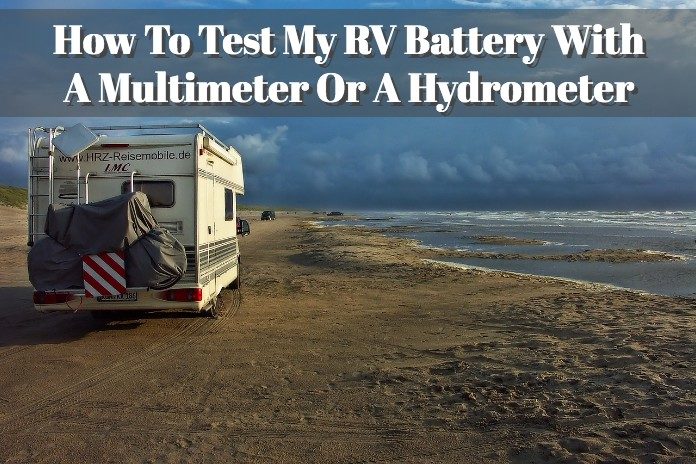
More often than not, people tend to ignore the existence of an RV battery, which is wrong. Well, the battery may not be the one responsible for starting the car or something. But, it’s accountable for lighting the RV during the dark moments. The battery is also tasked with powering electronics such as the fridge and television sets fixed in the RV. So, it’s recommended that you ensure that the battery remains in its best state.
So, how can you test your RV battery? Checking the battery of your RV is a simple procedure. You can carry out the task by yourself, without having to drive to any garage. But, you can make use of the garage’s free battery testing as this means a professional input. But, if you’re a DIY kind of a guy, you only need a multimeter or hydrometer, and you’re set to get done with the entire procedure.
How Often Should You Test Your RV Batteries?
Often, people are always asking if the battery tests are necessary. The truth is that they are highly needed as they help point out the state of the battery. With the results, it’s easy to tell what is required to enhance the battery, or the amount of time left for the RV battery to live. Therefore, you should make it a habit to check the battery regularly. Professionals always recommend that you test the battery at least once or twice a year.
However, if you notice a change in the battery’s performance, don’t hesitate to perform the test right away. Also, if you can’t remember the time you acquired the RV’s battery, the checks should be made frequent. The frequency is because the battery might be old and hence the need for a regular checkup. You never know, the testing can save you plenty of cash as you can prevent a problem before it becomes a disaster.
1. Test the Charge Using a Multi-meter
Testing the charge in your RV’s battery is crucial. Generally, this test get performed when you’re about to hit the road. By examining the amount of charge left in a cell, you’re in a position to tell if the battery will provide the power needed during the entire journey.
Remember, you need to keep the fridge, lights, or even tail-lights on while on the move. Thankfully, with your digital multi-meter, you can quickly test the charge left within a minute. You will need to follow the following procedure:
1. Set your voltmeter to 20 DC volts
2. Attach the black (negative) cable of your meter to the negative terminal of the battery
3. Go ahead and attach the red cable to the positive terminal of the RV’s battery
4. Check the digital readings
Interpreting the Readings
One fantastic thing about a digital multi-meter is that it gives a precise reading. You only need to know what the readings mean. For instance, a perfectly charged battery should have a reading of about 12.5 volts and higher. If you find your battery to be over 12.5 volts, it means that it’s good to go, and no charging is needed.
If the meter reads 12.3 volts, it means that the battery is 75% charged and hence requires a little bit more of charge. But, if you take a reading of 11.8 or below, it means that the battery is 25% charged and thus requires some time to fill it up. If the readings don’t change after charging the battery, it’s high time you considered asking for a battery replacement.
2. Electrolyte Gravity Test
The electrolyte gravity test is a test performed using a hydrometer to point out if your battery has charge or has a problem. For this specific test, it would be best if you picked a hydrometer that has a thermometer. Also, a self-adjusting hydrometer goes well if it came in handy. But, if you are used to the hydrometers with conversion tables, you can go ahead and use one.
When performing this test, practice caution because the test involves contact with the battery’s content, sulfuric acid. Remember to wear protective gloves and goggles before setting up to begin the test. With the gear, you are much protected from the damages that may arise from contact with the acids. Once, you’re ready, with the protective equipment on, follow the following procedure:
1. Open your battery caps to access the electrolyte
2. Insert the hydrometer in the opening, the first cell, and press the other end of the hydrometer, the bulb
3. Release the bulb so that the electrolyte can enter the device’s needle
4. Take the specific gravity as directed on the device’s manual
5. Record your readings and repeat the same procedure for the other openings, cells
6. Compare your readings to those provided by the battery’s manufacturer
Interpreting Results
Generally, if you find your readings happen to fall in between 1.265 and 1.299, it means that the RV’s battery is in a good state of charge. If the reading falls below 1.265, it should tell you that it’s undercharged. Such a reading should say to you that some charging is needed before hitting the road, as this can save you from any disappointment that may result from the battery running out of the charger.
Often, a trickle or slow charger can help with an undercharged battery. It can top up the battery in the shortest time possible. But, the charger can only help if the battery is in good shape. Professionals always insist that when you take a difference of 25-50 points between any readings, it should tell you that the battery is worn out. In this scenario, a replacement is the only solution.
Conclusion
Testing the battery of your RV is beneficial if it’s done regularly. The regular tests help point out a problem within your cell, and hence saving you money in the long run. As explained in this article, you can test your battery at least once or twice a year.
In this piece, you will find ways on how to check the battery in the comfort of your home. Read through the entire article to understand how to perform the tests and interpret the readings.





